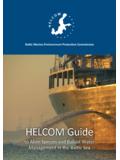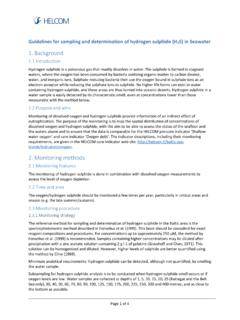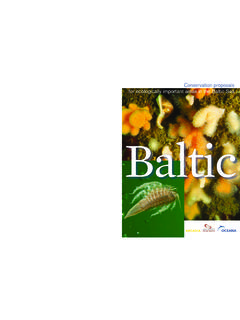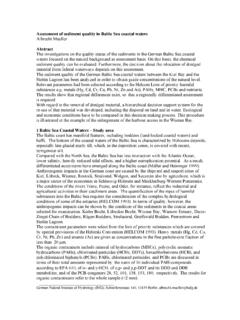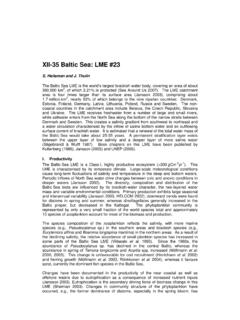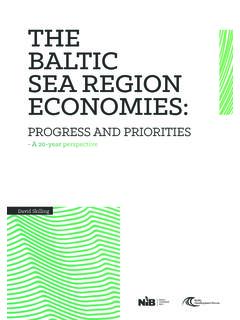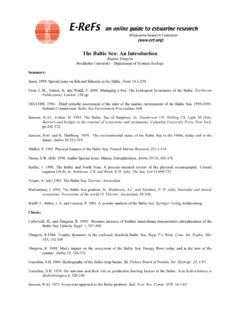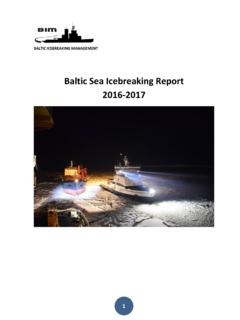Transcription of Overview of the status of the network of Baltic Sea marine ...
1 0 Overview of the status of the network of Baltic Sea marine protected areas HELCOM Baltic marine Environment Protection Commission 1 2 Overview of the status of the network of Baltic Sea marine protected areas HELCOM Baltic marine Environment Protection Commission 3 This is the Overview of the status of the network of Baltic Sea marine protected areas, compiled by the HELCOM PROTECT project. It was approved for publishing by HELCOM HOD 42/2013 (Minutes LD 35). Published by: Helsinki Commission Katajanokanlaituri 6 B FI-00160 Helsinki Finland Editor Maria Laamanen Authors Janica Borg, Jan Ekebom and Penina Blankett For bibliographic purposes this document should be cited as: HELCOM 2013.
2 HELCOM PROTECT- Overview of the status of the network of Baltic Sea marine protected areas. 31 pp. Information included in this publication or extracts thereof are free for citing on the condition that the complete reference of the publication is given as above. Copyright 2013 by the Baltic marine Environment Protection Commission HELCOM Lay out: Janica Borg Photo credits: Front cover: OCEANA Carlos Suarez Page 5: Christof Hermann, page 6: Jannica Haldin, page 8: OCEANA Carlos Minguell, page 9-10: OCEANA Carlos Suarez, page 11: Christof Hermann, page 12: OCEANA Carlos Suarez, page 14: Mets hallitus Natural Heritage Services/ Ulrika Bj rkman, page 15: Christof Hermann (above) and Mets hallitus Natural Heritage Services/ Mats Westerbom (below), page 16: Janica Borg, page 17: Christof Hermann, page 19: OCEANA Carlos Minguell, page 21: Mets hallitus Natural Heritage Services/ Julia Nystr m, page 22.
3 Mets hallitus Natural Heritage Services/ Mats Westerbom, page 24-25: OCEANA Carlos Minguell, page 26: Christof Hermann, page 27-28: OCEANA Carlos Minguell, page 29: Christof Hermann Number of pages: 31 4 Contents Executive summary .. 5 1. Introduction .. 7 The purpose of this Overview .. 7 The concept of Baltic Sea protected Areas (BSPAs) .. 7 Other networks of protected areas in the HELCOM 8 Linkages with European and global initiatives concerning marine protected areas .. 9 Data reporting for HELCOM Contracting Parties which are also EU Member States .. 9 IUCN classes of the BSPAs .. 10 2. Target: An ecologically coherent network of well-managed protected areas.
4 11 3. Current status : How far are we from reaching the targets? .. 12 Overview of BSPAs .. 12 Reasons for designating BSPAs and threats to the areas .. 15 Overview of management plans and measures .. 17 Development since the previous assessment of the BSPAs network in 2010 .. 20 Overlap of Natura 2000 areas and BSPAs .. 23 Legal protection of BSPAs and their IUCN categories .. 24 4. Trends and future needs .. 25 Needs stemming from global frameworks and the EU .. 25 Impact of climate change on protected areas .. 26 5. Next steps towards reaching the targets for the network of marine protected areas .. 27 Needs for the review of HELCOM Recommendation 15/5 on BSPAs.
5 27 Modernisation of the HELCOM BSPAs database .. 27 Next steps for the protected areas in the Baltic Sea .. 28 References .. 30 5 Executive summary In the past ten years good progress has been made in enlarging the network of protected areas: between 2004 and 2013 the protected marine area has increased from to The network of Baltic Sea marine protected areas continued its growth also between 2010 and 2013. Five new areas were established as Baltic Sea protected Areas (BSPAs) since 2010: three in Latvia and two in Lithuania. For some areas the borders were redefined, resulting in a change of coverage area .
6 The network of BSPAs currently covers of the total marine area of the Baltic Sea. The 10% target of the UN CBD for the whole Baltic was attained already in 2010. The HELCOM 2010 Ministerial Meeting set a 10% target for each sub-basin, when scientifically justified. This target has now also been reached in all other sub-basins except the Baltic Proper and the Gulf of Bothnia. In the Baltic Proper of the total area was covered by BSPAs and in the Gulf of Bothnia The Contracting Parties ought to consider strengthening the network also in these two sub-basins. The HELCOM 2010 target to include more off-shore areas under the protection regime by the end of 2011 had not been reached between 2010 and 2013.
7 Despite the overall increase in protected areas the fraction of protected areas in the Exclusive Economic Zone (EEZ) had not increased. The only new protection of the Exclusive Economic Zone resulted from an expansion of a Latvian BSPA, which now also encompasses 156 km2 of EEZ. In comparison, the increase of protected Territorial Waters since 2010 was 5 421 km2. The Baltic Sea Action Plan published in 2007 encouraged those Contracting Parties that are also EU Member States to designate Natura 2000 areas as BSPAs. According to the 2011 data on Natura 2000 areas and the 2013 data on BSPAs, 64% of Natura 2000 sites had been nominated also as BSPAs.
8 This implies a decline from 83% reported in 2010. By 2013, the total area of Natura 2000 sites had increased by 23 864 km2, while the total area of BSPAs had increased only by 4 858 km2, resulting in the decline of the fraction. Biological and marine values as well as ecologically significant habitats were most often reported as reasons for selecting an area as a BSPA in 2013, and there was no major change in these reasons since 2010. One of the HELCOM 2010 aims for the network of protected areas was to protect threatened and/or declining species and habitats by the end of 2011. Threatened and declining species and habitats ranked only 13th and 15th of reasons for selecting an area as BSPA, indicating that the Contracting Parties had not placed much emphasis to this target when selecting the sites.
9 With the new HELCOM Red Lists of Baltic Sea species and habitats, a more thorough evaluation of this aspect should be carried out in the future, and the Contracting Parties should continue their efforts to improve the protection for these species and habitats. This time it was not possible to evaluate the ecological coherence of the network , but it can be presumed that the addition of the few areas has not strengthened the network to the extent that ecological coherence would have been reached. HELCOM ought to compile relevant data for species and biotopes as well as human pressures and threats, and carry out such an analysis in 2014.
10 The most frequently reported existing threats in the protected areas were eutrophication, general pollution and commercial fishing. The most frequently Photo: Christof Hermann 6 reported potential future threats were oil spills, alien species and pollution from shipping. Dumping was considered to be most prevalent past threat that still has an impact on the area . Compared to the information from 2010, commercial fishing was considered a more serious present threat in 2013. The order of the other threats had remained the same. Although climate change was not included in the categories available in the questionnaire, it is an increasing threat to the biodiversity, for example through causing changes in the distribution ranges of species in the Baltic Sea.

